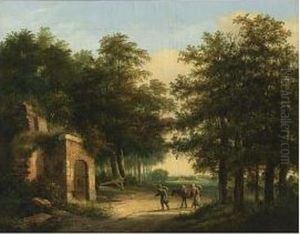Henricus Franziscus Wiertz Paintings
Antoine Joseph Wiertz, known as Henri or Henricus Franciscus Wiertz, was a Belgian romantic painter and sculptor born on February 22, 1806, in Dinant, then part of the French Empire, now Belgium. Wiertz was a controversial figure in his time, known for his grandiose and often macabre works that reflected a fascination with the morbid and the supernatural. His style combined elements of Romanticism with a certain predilection for the grotesque, which distinguished his oeuvre from that of his contemporaries.
Wiertz studied at the Antwerp Academy of Fine Arts where he developed his distinctive style. He was influenced by the works of artists like Rubens and the burgeoning Romantic movement that emphasized emotion and individualism, a clear departure from the Neoclassical emphasis on order and restraint. In 1832, he won the prestigious Prix de Rome, which allowed him to study in Italy. His time in Rome further cemented his interest in the grandeur of High Renaissance art and the dramatic storytelling of Baroque painters.
After returning to Belgium, Wiertz continued to work on large-scale paintings, often with a theatrical flair that bordered on the excessive. His ambitious nature drove him to create enormous canvases, some so large that they posed practical challenges for exhibition and conservation. His subjects ranged from scenes inspired by classical mythology and literature to contemporary social issues, and he often infused them with a sense of moralism or allegory.
Despite his ambitions, Wiertz's works received mixed reviews. While some admired his boldness and originality, others criticized his melodramatic approach and lack of restraint. Financial success eluded him throughout most of his career, but he continued to paint with passion and conviction. In a bid to preserve his legacy and make his art accessible to the public, Wiertz negotiated with the Belgian government to create a museum dedicated to his works. The result was the Wiertz Museum in Brussels, which was established upon his death in 1865 and remains open to this day, housing many of his major paintings and sculptures.
Wiertz's influence on subsequent generations of artists has been limited, as his style was often seen as too idiosyncratic and out of step with the evolving tastes of the late 19th century. Nevertheless, his work provides a fascinating window into the Romantic spirit of his age, embodying the period's attraction to the sublime, the terrifying, and the otherworldly. Henri Wiertz passed away on June 18, 1865, in Brussels, Belgium.





